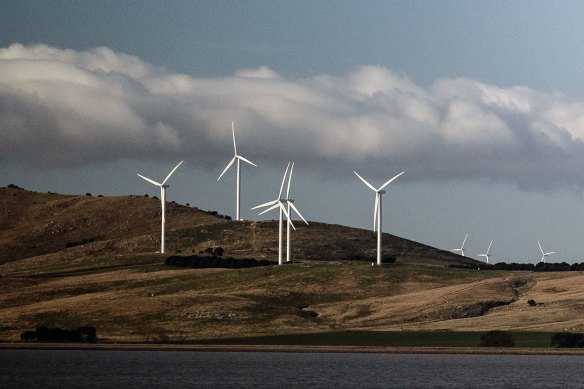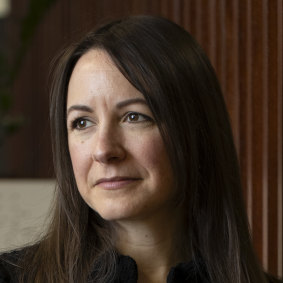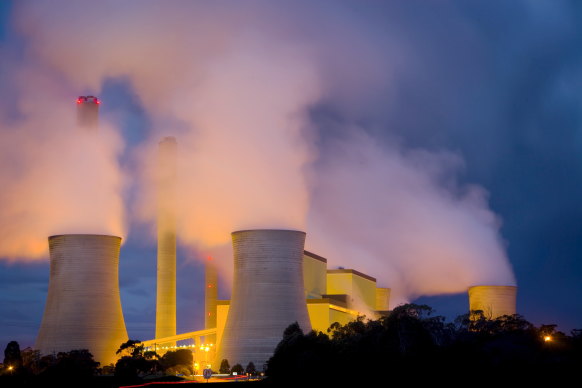By Nick Toscano
Stronger winds and heavier rainfall in eastern Australia have boosted renewable energy generation and pummelled coal to its lowest share of the grid on record for this time of the year.
For much of 2024, unfavourable weather for renewables has forced generators to burn more coal and natural gas than usual to meet demand, unleashing more planet-warming emissions into the atmosphere and driving up wholesale power prices.

Green energy production from Australia’s wind turbines and hydroelectric dams has been rising since September.Credit: Hilary Wardhaugh
But green energy production from Australia’s wind turbines and hydroelectric dams has been rising sharply since September, new figures reveal, while milder weather has subdued demand.
The rebound for renewables has squeezed coal-fired power stations – the grid’s dominant sources of supply – to their lowest seasonal contributions to date for September and October, of 52 per cent and 50 per cent of the overall power mix, respectively.
The shift has also led to big falls in wholesale power prices, said Schneider Electric senior director Lisa Zembrodt, who advises some of Australia’s biggest corporate energy users. Since the start of September, improved output from cheaper-to-run wind, solar and hydroelectric sources had reduced the need to call on more expensive fossil fuels, she said.
“We are really seeing what we would expect to see as more renewables move into a grid – the fossil fuels get squeezed out,” Zembrodt said.
Wholesale electricity prices – what retailers pay generators for power before supplying it to customers – soared by 88 per cent to an average of $119 per megawatt-hour in July, August and September compared to the same period last year. This was partly due to an east-coast wind lull and low rainfall in Tasmania, which reduced the availability of cheap output from hydroelectric dams.
At the same time, intense demand from power-hungry heaters during winter drove up the need for higher-cost gas and coal plants to make up for weak renewable generation.
However, wholesale prices started retreating in September, according to the Australian Energy Market Operator (AEMO), averaging $46 a megawatt-hour for the month and $50 a megawatt-hour in October.

Lisa Zembrodt, head of energy transition and sustainability at Schneider Electric.Credit: Arsineh Houspian
If sustained, the declines could help lower the risk of electricity bills rising sharply next year. Regulators take average wholesale prices into account in May when they reset each state’s annual default market offers – the maximum that retailers can charge customers who do not take up special deals.
Still, Zembrodt said the threat of a price hike remained, with much now depending on how the grid manages the strain of high air-conditioning use over the typically challenging summer months ahead, especially after the sun sets.
“We’ve seen prices come off,” she said.
“The big question is what demand is going to look like over the next few months – and that will be weather-driven,” she said.
Continued growth in renewable energy output will also put more pressure on coal, Zembrodt said, referring to newly connected wind farms in Queensland and Victoria that are now in their final stages of testing before delivering power to the grid.
The share of power generated from the sun, wind and water is expanding each year in Australia, and now accounts for between 38 and 40 per cent of the grid’s annual average power mix, as billions of dollars continue pouring into large-scale and household renewable energy.

Coal-burning power stations, the dominant source of Australia’s electricity for more than half a century, now account for roughly half.Credit: Fairfax
The transition is still lagging the speed that experts say is required for Australia to achieve its 2030 emissions-reduction and clean energy targets, but the build-out of renewables keeps setting records, according to AEMO.
The total volume of new renewable energy capacity in the process of connecting to the grid during the September quarter soared 36 per cent compared to the same time last year, AEMO said, with more than 45 gigawatts of new capacity moving through the connection process. That is equal to about 70 per cent of the grid’s existing generating capacity.
“It is promising to see Australia’s energy transition continue with more renewable generation capacity either coming online or progressing,” said Violette Mouchaileh, AEMO’s general manager of reform delivery.
Coal still typically accounts for up to 60 per cent of Australia’s average electricity generation, but at least half of the remaining coal-powered generators in eastern states are due to retire within the next decade, as the ageing and emissions-intensive equipment become less reliable and competitive against cheaper renewables.
The Business Briefing newsletter delivers major stories, exclusive coverage and expert opinion. Sign up to get it every weekday morning.